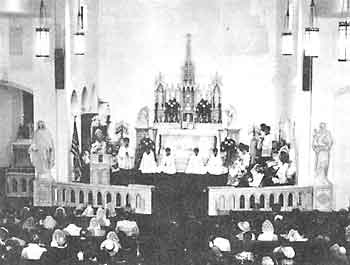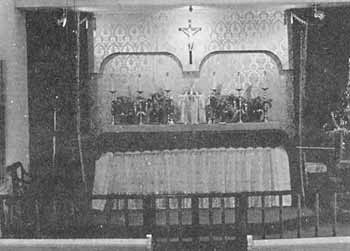Citadels of Faith
where parishioners "pray to God and ply the hammer"
Louisiana
OUR LADY OF GRACE ACADEMY, the only traditional Catholic school in the City of New Orleans, opened its doors for the first time on Monday, August 28, 1978. The school has the largest enrollment of all the schools of the Society of the St. Pius X in the United States with 87 students. This facility of education has become the reality of our hopes and dreams for as true Catholic parents we realize that it is our responsibility before God and man to have our children educated in a good Catholic school wherever possible.
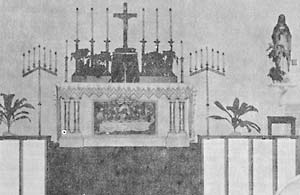
The main altar at Our Lady of Grace Chapel which has been completely restored by parishioners. Much work has been completed in recent months and an expansion of the facilities is anticipated in the future.
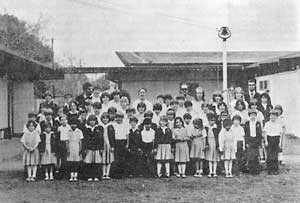
The lower grades at Our Lady of Grace Academy, pictured with their teachers shortly after the opening of the school in the Fall of 1978. The Academy is located in Kenner, Louisiana, a suburb of New Orleans.
The site of Our Lady of Grace Chapel and Academy was purchased from members of Christ the King Lutheran Asssembly. The size of the land is 1.14 acres and it includes a small chapel, a rectory with carport, eleven classrooms, a kitchen and library.
Our Lady of Grace Academy consists of a preschool, kindergarten, and first through ninth grades. The academic program is designed to develop the student spiritually, intellectually, physically, and emotionally. The Academy places its emphasis on the basic skills in order to develop the intellect to its fullest capacity. The children are made aware of their responsibilities as students of this Academy in order to reach the highest goals in spirituality and education. The purpose of the school is to provide the students with the proper Catholic education in accordance with the teachings of the Church. Proper guidance, understanding, and discipline are necessary in the elementary years and we hope to be able to assist the students in the development of their morals, spiritual values, and proper standards of conduct and integrity.
The renovation of the Chapel and Academy from a Lutheran place of worship and a pre-school center to a Catholic chapel and school was, at times, exhausting and discouraging. But somehow, through the grace of Almighty God, the work continued. The eagerness and determination of friends working so closely together for a common goal was overwhelming.
We have placed our values, goals and ideals high for the glory of God. He and His Holy Mother have chosen to smile upon this small Catholic mission and to shower it with abundant blessings from Heaven.
—Sandy Cerise
California
THE CALIFORNIA "BRANCH" of the Society of Saint Pius X began on August 25, 1974, when the first public Mass was celebrated by Father Gregory Post (a graduate of Ecône) at a home in San Jose and attended by a few interested people who had heard about it.
The group soon began renting whatever larger accommodations they could find available—a vacant store, a hall, a warehouse, a chapel and an American Legion Hall in San Jose. Father Post traveled by car and by plane to other places in California to bring the Mass to people who were asking for it in other communities—Walnut Creek, Concord, Sacramento, Bakersfield, Santa Rosa, San Diego, Carlsbad.
But this is the story of how the San Jose group acquired their own chapel. Before we got into the problems of buying our own, we had the problems of dealing with renting and moving and always being in a temporary state as the places were leased or sold from under us. Each time it became necessary for our San Jose center to move from one rented place to another the men of the congregation saved us money by personally moving the altar and church equipment themselves.
Our great goal was to buy property of our own where the chapel and rectory could be in one place and we would be able to make visits to the Blessed Sacrament. But property at this time (1976 and early 1977) was at an all-time inflationary high, much to our dismay, and we were anything but wealthy! However we were determined to give it a try and take a positive step. One family in our congregation had non-Catholic relatives who owned the right sort of property for our needs, at 110 West Latimer in Campbell, California. It contained enough land for parking requirements and we felt the large old house, which had been standing idle for a long time, had possibilities of being converted into a chapel and rectory. It was in a good location, close to freeways. After much prayer, thought, discussion and investigation, on May 31, 1977, our Saint Pius X Chapel negotiated to buy this property.
The Chapel in Campbell has now been dedicated to Our Mother of Perpetual Help. Remodeling work continues, with members of the Men's Club busy converting the garage into a library which will have coffee facilities and serve as a meeting room also.
Since the men do the remodeling at Our Mother of Perpetual Help in their spare time on Saturdays, it's been a slow process to finish each undertaking, and their work has been continuous since 1977. It may not seem like a big deal to read about a group buying a large old house and remodeling it into a chapel unless you have been involved in such an effort yourself. People just don't realize how many problems must be resolved. Most of us were green about such matters because in the "old days" the Archdiocesan offices made the decisions concerning church buildings. The average parishioner contributed some money, but his role ended there. At Our Mother of Perpetual Help we are now experienced in all the details of doing it from scratch and without the income of a large parish. We found out if we wanted a proper traditional chapel, we must "pray to God and ply the hammer."
We dealt with one hurdle at a time, beginning with money. The pledge system raised part of the money for the down payment on our own property and we borrowed the rest. Another problem was finding the right piece of property to buy. Properties must be searched for, investigated, owners contacted, negotiations started, offers and count-offers exchanged, the Society's approval given, agreements signed. Sketches and drawings must be made and submitted to City authorities, revised and re-submitted to comply with the many building code requirements. At least a dozen trips to city hall and to city council meetings were necessary. Costs must be figured and re-figured. Estimates showed clearly that if we could do the work ourselves, we would save many thousands of dollars. So the men did everything possible themselves and we employed outside professionals only when we absolutely had to.
The property we purchased looked like a disaster area at first because it had to be cleared off and cleaned up. Several weekends were spent in removing truckloads of trash. Men, women, and teenagers painted, cleaned, hammered, washed windows. Walls were taken out, walls were put back. Roofing, wiring, plumbing, more painting, refinishing floors, carpeting and draperies, landscaping—it all finally came together enough that we could open the chapel in November 1977. But several projects still remained on the wanted list, so the men have been working on Saturdays ever since, contributing their time and expertise to complete one task after another. I don't know if they are looking upon it as a privilege or a penance, but they are getting the job done! And when they finish the library, the next plan awaiting them is to add a room onto the chapel which will seat another 40 people.
The important thing is that a stable congregation can have its own chapel even if it does not have a large amount of money or wealthy donors. You make use of the areas of expertise within the congregation. Once people realize that they must take action themselves and not wait for someone else to do the work and make the decisions, they can have a chapel.
—Kay Kidd
Texas
IN A SMALL TEXAS TOWN at the intersection of two busy highways, a white Spanish-style church stands as a landmark to the area. Not everyone recognizes it by its name, Queen of Angels, but anyone in town can direct you to the big white church on the corner!
Dickinson, Texas, is a town with a population somewhere around 10,000 people. Its history is as old as the first settlers in Texas and almost as colorful. It has seen Indians (buffalos once roamed along its bayous) and cowboys as well as gamblers and bootlegged whiskey during the prohibition years. What once was the "Strawberry Capitol of the World" is now a more subdued suburban town. Geographically, it is located halfway between Houston on the north and Galveston on the Gulf Coast. It stands out from the plains surrounding it much like an oasis with its winding bayous and tall pine trees.
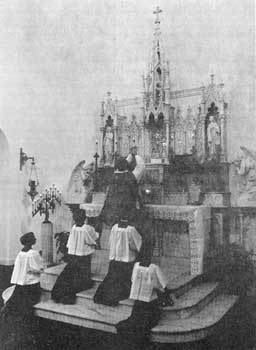 |
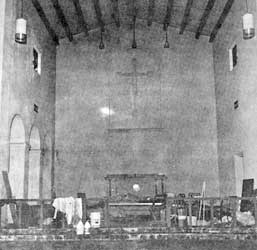 |
The history of the church began in 1909. It was a mission church where the priest was a circuit rider on horseback. The original church no longer stands but the rectory and convent built in 1926 still remain. The church as it is today was built in 1946 as was the school.
In 1976 when Archbishop Lefebvre visited Texas he requested that a house for the Society of St. Pius X be established in the area. In November 1976 this property was purchased from the Houston-Galveston Diocese. On December 8, 1976, the first Holy Mass was celebrated in the parish hall which had been prepared for the occasion. Much work needed to be done since the property had been abandoned in 1974 when the congregation it had served for so many years built a more "modern" edifice two miles to the west. The property had stood vacant and unattended for almost three years.
At first sight it was hard for anyone to imagine how it would ever be possible to renovate a church, rectory, convent and parish hall before the scheduled dedication by Archbishop Lefebvre in July, 1977, just eight months from the actual time of purchase!
But renovated it was by all of the parishioners who worked tirelessly to get the job done. The interior of the church was bereft of any religious furnishings save one "altar table". The Society was fortunate in being able to acquire the contents of St. Joseph's Hospital Chapel in Kansas City, Missouri, including three beautiful marble altars, a curved marble communion railing, statues and pedestals, Stations of the Cross and two beautiful paintings—one of the Assumption and the other of St. Joseph and the Child Jesus. All buildings were painted inside and out and roofs repaired, as well as a myriad of other things that made the residences livable. The grounds, all three acres, had been groomed and readied for His Excellency's pending visit. Truly, as one looks back on it now, a miracle had taken place. A minor one, perhaps, but everyone who took part knows that somehow none of this could have been accomplished except by the grace of God. Anyone will tell you it just wasn't humanly possible and many did express this to the pastor, Fr. Hector Bolduc! To Father Bolduc, however, anything is possible with God's grace and all felt, even then, he had an extra special helping of that.
So it was that on July 10, 1977, this church was dedicated to Our Lady, Queen of the Angels, by Archbishop Marcel Lefebvre. Hundreds of people came from all over the country to witness that event and from that day on Dickinson and the world would never be the same.
After dedication much remained to be done. Queen of Angels Academy opened in the Fall of 1977 to a full eight grades and four teachers. In its second year of operation, the Academy presently has an enrollment of 26 pupils.
November, 1977 was the beginning of The Angelus Press. The first issue was a very special one prepared for the first anniversary celebration of the purchase of the property. THE ANGELUS became an official publication with the January, 1978 issue. From that point on it has increased in readership and is now distributed worldwide. It is printed on the property by Father Carl Pulvermacher, who is scheduled to print when he isn't traveling on a Mass circuit. With help from parishioners it is assembled and mailed each month.
Looking back to its earliest beginning as a mission church, one realizes the similarities of that early mission to today. Although airplanes have replaced horses, the objective remains the same—to bring the Mass and Sacraments to as many people as possible. Three priests travel in excess of 50,000 miles each month to 19 cities from this location.
It seems a fitting tribute to this church that once again it serves the purpose for which it was originally began—to preserve and spread the Faith for the greater honor and glory of God.
—Irene Slovak
IN THE SUMMER OF 1977 the Society of St. Pius X Mission in San Antonio had managed to raise and save enough money to make the down payment on an old dilapidated duplex house at 803 East Magnolia Avenue. It was a terrible eye-sore and when the members saw it their hearts sank with discouragement. Nonetheless, they pitched in, cleaned up the place, tore down a partition wall to form a chapel, repaired and repainted everything and were finally able to move in.
It was a relief to have a place of their very own after having spent almost three years in the Holiday Inn and Travelodge. It was also wonderful to at last have the presence of the Blessed Sacrament.
Since the purchase, the other side of the house has been renovated and furnished creating a nice apartment for the priests.
The last move of this group, and just in time for Christmas, 1978, was to install a central air and heat unit, open the ceiling over the chapel to form a choir loft and a vaulted cathedral ceiling over the main part of the chapel. Then a glass window was cut in the side of the sanctuary and speaker installed so mothers with noisy babies could see and hear the Mass from the crying room!
The sanctuary was likewise enlarged, beautified, carpeted in cardinal red and fitted with a lovely Communion railing. To top it all off, a magnificent Wurlitzer Organ was donated just in time for the Christmas Masses. The beautiful strains of familiar Christmas carols ably played by our talented organist, Gene Dorantes, moved all to more deeply appreciate the lovely architectural enhancements. The excellent choir sang the Midnight mass on Sunday morning at the behest of Father Terence Finnegan and the Third Mass of Christmas in the evening of Christmas Day. Father Finnegan celebrated all Masses of that weekend and enjoyed sharing the happiness of the members in San Antonio.
The San Antonio Mission, though small, has a wonderful spirit of cooperation. They are well-organized and there is a feeling of solidarity that one can sense about everything. Everyone helped in his own way to make all of this renovation possible. The greater part of the credit, however, goes to Albert Gonzales, who designed and directed everything, cut the balusters for the Communion Rail and balustrade supporting the choir loft with his own hands; and Gene Garza, who installed the central air and heat unit and who worked side by side with Mr. Gonzales and Joe Ezell in all the details of the construction.
The people in San Antonio view the transformation of their Saint Joseph's Roman Catholic Chapel with pride and attribute their success to the helpfulness of St. Joseph and to the daily recitation of the Rosary in the Chapel before the Blessed Sacrament. This practice was begun in October of 1977 and is still continuing. As a result, their blessings have not ceased to pour in and a peacefulness, not heretofore known, has settled on this little flock.
—Dorothy Carabetta
Pennsylvania
ON FEBRUARY 13, 1972, a group of seventy-five traditional Catholics heralded the restoration of the Traditional Latin Mass in Pittsburgh in the ballroom of the Roosevelt Hotel. The second Mass was offered on March 19th, the Feast of Saint Joseph, the Patron of the Universal Church, and through his intercession, we have had Holy Mass every Sunday since then without interruption.
Holy Mass was offered in the Roosevelt Hotel from February to September of 1972. In August of that year we found a vacant church that was owned by a Serbian Orthodox Congregation. We rented the building; cleaned, painted and furnished it in three weeks. We dedicated it to our Blessed Mother under the title "Our Lady of Fatima" and had our first Mass there on September 17, 1972. There was a house in the rear that was occupied by the Serbian priest, which we also rented as a rectory for a priest whenever God, in His Infinite Goodness, sent us one.
Father John Keane from Boston came every weekend during the first year and Father Lino, a Spanish priest from New York, traveled from New York every weekend during the second year. In 1974 Father Leo Friederichs came several times for short visits, and in September agreed to stay here as our Spiritual Director, which meant that we had the inestimable privilege of daily Mass in addition to Sunday Mass.
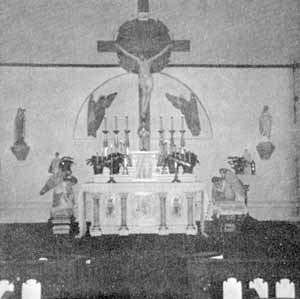
In December 1973 we began to sponsor a radio broadcast of the Rosary at noon every Sunday on WEDO to give thanks and praise to our Blessed Mother who obtained so many graces for us.
Then, in March of 1975 we decided to have the High Mass broadcast live every Sunday from Our Lady of Fatima Chapel at 10:00 a.m. on WEDO also, in an effort to reach many who did not know that the True Mass was still being offered and to bring comfort and solace to them and to the elderly and sick. Financially, both of these broadcasts mean a loss, but we put our trust in Divine Providence, praying that this sacrifice will bring about the salvation of many souls.
To spread further the Reign of Christ we held a Eucharistic Rally on Sunday, October 27, 1974, the traditional date for the Feast of Christ the King. The day started with a Solemn High Mass in the ballroom of the Hilton Hotel because the Chapel was not large enough to accommodate the 500 people who came. There were seven priests and Catholics from many states traveled here for the day. After Mass we went in procession through Point State Park in downtown Pittsburgh, to demonstrate publicly our faith in and our love and devotion to Christ, the King and Center of all hearts. We have held a Eucharistic Rally each year since then on the last Sunday in October. In 1978 we decided to expand it to a three day Retreat to satisfy the desire of many Catholics to attend a traditional Retreat. During the three days we heard excellent sermons from the four priests in attendance: Father Leo, the host priest; Father Hector Bolduc, Father Lino and Father Michael Jarecki. With the help of God, we are hoping to hold a Three Day Eucharistic Retreat again in 1979 from October 26 to 28th.
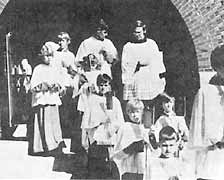 |
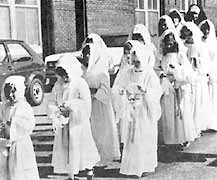 |
As another continuing effort to spread the Reign of Christ, we began the publication of a quarterly paper THE CATACOMB which presents an article each issue by Father Leo, along with devotional material to help us to know and love God more and to save our souls.
On September 7, 1978, we undertook what is probably the most important task of every traditional group—the establishment of a Catholic school. The school contains grades one through eight and a faculty of one full-time religious and five part-time lay teachers.
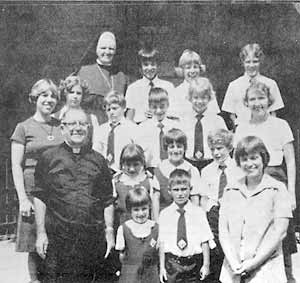
When we moved into the building that houses our Chapel, we were just renting and we continued to pay rent for the next several years because we were reluctant to incur any large debt that would necessitate too much concern with raising money that would take our attention away from the more important work of restoring the Mass and the ceremonies of the Church. In 1977 we appealed to all members of the congregation to loan money interest free to enable us to purchase the Chapel, the rectory and a vacant lot which adjoins the Chapel. The response was overwhelming and we were able to buy all the property without borrowing money from any lending institution, thanks be to God!
Additional information about Our Lady of Fatima Chapel may be obtained by writing to 2107 Sidney Street, Pittsburgh, Pa. 15203.
—Ann Schuster
THE ANGELUS would very much like to receive articles accompanied by pictures from traditionalist groups in every Country where there is an ANGELUS subscriber! We have received more response about our articles dealing with traditionalist activities than any other single item in our fourteen issues. We are also attempting to compile a listing of Mass locations other than the Society of St. Pius X which you will find elsewhere in this issue! If you can, please assist us.
